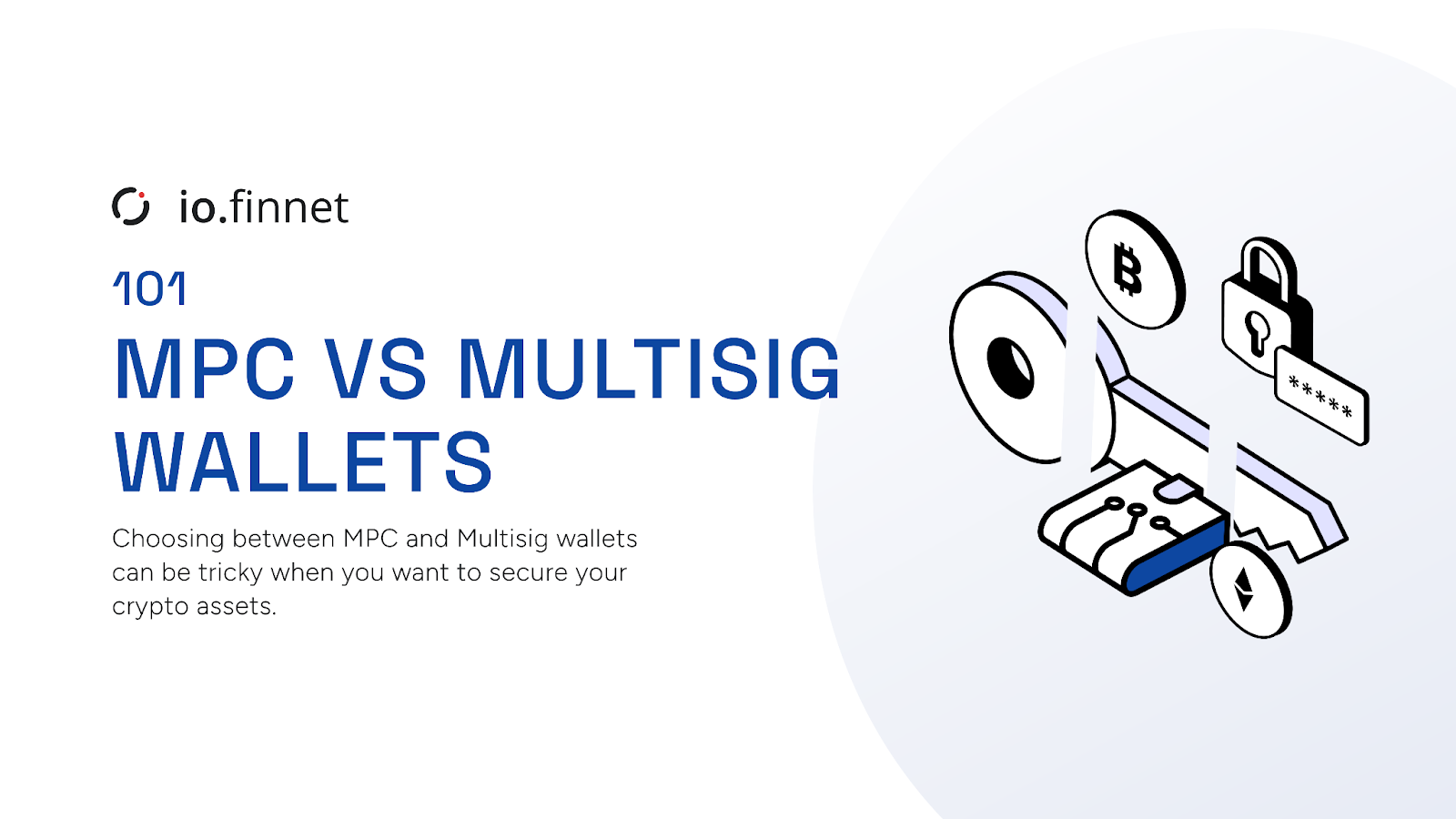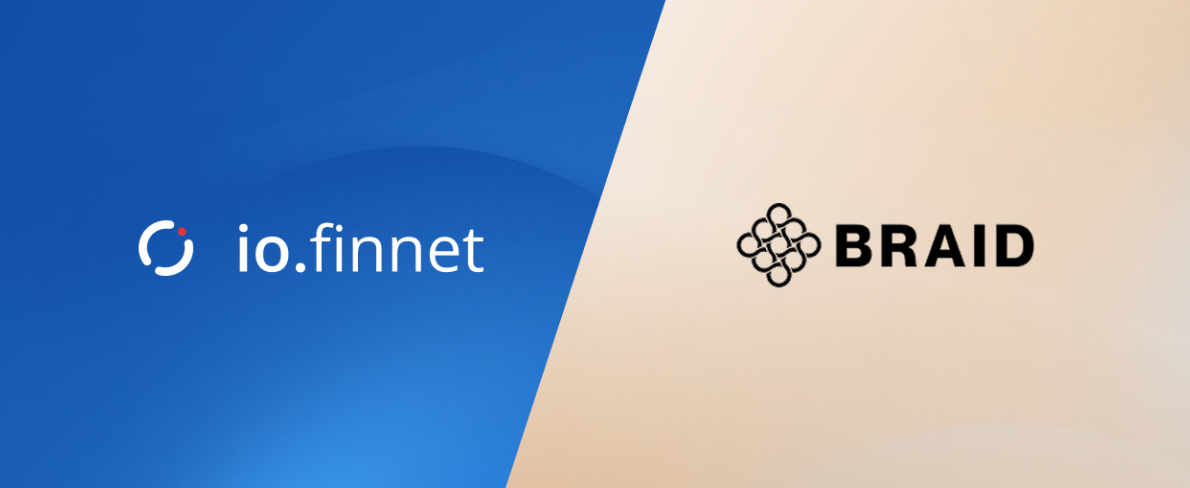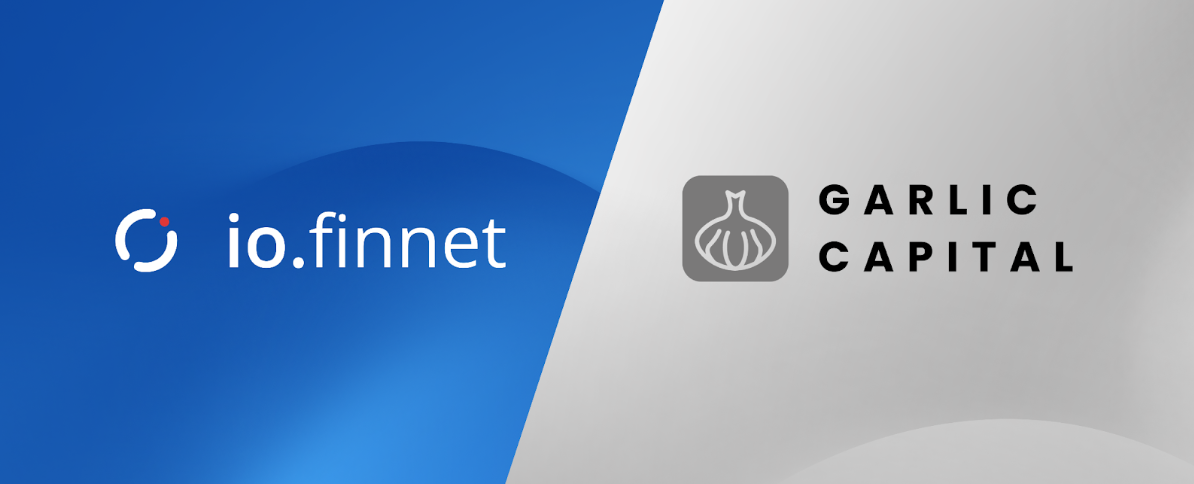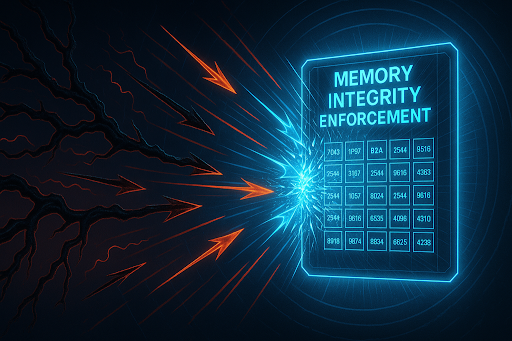LEARN
MPC vs Multisig Wallets: Which Is Best in 2025?
Choosing between MPC and Multisig wallets can be tricky when you want to secure your crypto assets.
Both options offer strong protection but take very different approaches.
So, which one should you choose?
We’re here to simplify things for you.
We'll explore the key differences between MPC vs Multisig wallets so you can easily pick the best fit for your needs. To make your life even easier, we’ll take you through a robust digital wallet solution that keeps your crypto assets safe and secure.

This Article Contains
- What Is an MPC Wallet?
- What Is a Multisig Wallet?
- MPC vs Multisig Wallets: Quick Feature Comparison
- MPC vs Multisig Wallets: 8 Key Differences Explained
- io.finnet: A Powerful MPC-Based Self-Custody Solution
- 3 FAQs About MPC and Multisig Wallets
A Multi-Party Computation (MPC) wallet is a digital wallet that distributes the key generation and transaction signing processes across multiple parties. Instead of relying on a single private key, it splits responsibilities among several participants to enhance security.
What’s so special about this type of arrangement?
It allows transactions to be authorized only when a required number of parties utilize their individual key shares. Now, the security advantage of this method is that the full key is never fully assembled in one location, which minimizes the risk of total key compromise.
Additionally, an MPC solution is blockchain agnostic, meaning it can operate seamlessly across different blockchain technologies. This enhances its usability in managing a variety of digital assets.
Next, let’s look at how a multi sig wallet works.
A Multi-Signature (Multisig) wallet is a digital wallet that enhances security by requiring multiple signatures to authorize a transaction. Each participant in a Multi sig wallet holds a unique key, and transactions are executed only when the predetermined number of signatures is met.
This setup is ideal for situations requiring shared control over funds, such as organizational expenditures or joint account management.
The distributed signature requirement in Multi sig wallets reduces the risk associated with the compromise of a single key. Additionally, it adds a layer of transparency to transaction processes.
However, Multisig functionality is dependent on specific blockchain protocols that support it, which can restrict its use to particular networks or require multiple deployments and configurations, increasing operational complexity.
Now that the basics are out of the way, let’s check out how these two digital wallets compare.
To provide you with a quick overview, here’s a table comparing the features of MPC and Multisig wallets:

Clearly, an MPC-based wallet excels in many aspects. So, let’s dive deeper to find out why it stands out.
MPC and Multisig wallets are distinct across several aspects, including security features, transaction speed, cost implications, and more. Let's explore all this in more detail:
- Security Features
- Transaction Speed and Cost Implications
- Operational Flexibility and Scalability
- Blockchain Compatibility and Multichain Support
- Key Management and Approval Quorum
- Privacy and Anonymity
- Recovery Options
- User Experience and Adoption
Security features are crucial for protecting digital assets against threats and unauthorized access, serving as the first line of defense in wallet technologies. In fact, a superior security foundation ensures that assets remain protected even if parts of the system are compromised.
Let’s explore how each solution prioritizes security:
- MPC: Enhances security by distributing the computation of private keys among multiple participants, ensuring no single party has complete access. This decentralized approach significantly reduces the risk of a single point of failure or insider attack.
- Multisig: Increases security through the requirement of multiple approvals for transactions, which reduces the risk of fraud or theft by any single key holder.
The speed of transactions and their associated costs are critical factors that influence the usability and adoption of blockchain technologies. Faster, more cost-effective transactions tend to encourage greater user adoption and support more efficient operations.
- MPC: Transactions through an MPC solution are generally faster, as the protocol often requires fewer interactions with the blockchain, which also results in lower transaction fees. This efficiency makes MultiParty Computation attractive for applications that demand quick transaction processing.
- Multisig: Typically slower and more costly due to the multiple signatures required, each needing to be verified on the blockchain. These additional verifications increase both the time to complete a transaction and the total gas or network fees incurred.
Operational flexibility refers to the ability of a system to adapt to changes in its environment or demands, while scalability addresses the capability to handle growth in workload and transaction volume. Wallet solutions must excel in both to remain viable as user bases and transaction loads expand.
- MPC: Offers remarkable scalability and flexibility, and can efficiently handle more transactions and participants without experiencing performance issues. Its design makes it suitable for both small teams and large enterprises that handle complex operations.
- Multisig: Though robust, it faces challenges in flexibility and scaling due to the complexity of coordinating among multiple participants. As the number of required signers grows, transaction management becomes increasingly cumbersome and costly.
Compatibility with various blockchain protocols and the ability to support multiple blockchain networks are crucial in digital wallets.
Why?
Because greater compatibility allows users and businesses to operate seamlessly across different blockchain ecosystems, making the wallet more versatile and future-proof.
- MPC: As we’ve explored earlier, Multi-Party Computation is generally blockchain agnostic, meaning it can integrate seamlessly with various blockchain systems. This flexibility makes MPC-based wallets a strong choice for multichain environments or cross-chain applications.
- Multisig: Multi sig wallets often have limitations regarding the blockchain protocols they support, which can restrict their use to specific networks that accommodate the multisig functionality. While a multisignature wallet is natively supported on major blockchains like Bitcoin and Ethereum, MPC’s blockchain-agnostic nature remains an advantage.
Effective key management and a robust approval process are essential for maintaining the security, integrity, and operational efficiency of blockchain wallets.
But what exactly do these refer to?
Key management focuses on how cryptographic keys are created, stored, distributed, and protected within the system. Meanwhile, an approval quorum defines the minimum number of signatures or approvals required to authorize a transaction.
- MPC: Facilitates easier management with decentralized key control, enhancing operational efficiency. Users and organizations can maintain high levels of security without needing to manually coordinate multiple key holders for each transaction.
- Multisig: Requires strict management of multiple keys and a predefined number of signatures to approve transactions, which enhances security but complicates operations. Each participant must securely store their own key and be available for transaction approvals, increasing administrative overhead.
Privacy and anonymity are critical in protecting user identities and transaction details from being publicly accessible. A wallet’s ability to safeguard user data is essential for maintaining trust and regulatory compliance with privacy standards.
- MPC: Provides strong privacy protections by ensuring that individual key segments are never fully assembled, which maintains user anonymity even during transactions. This decentralized key management prevents sensitive user information from being exposed on-chain.
- Multisig: Although Multisig secures transaction approval through distributed trust, the multiple signatures required are typically visible on the blockchain, which could potentially expose user identities and activities. This transparency can create vulnerabilities for users who prioritize privacy. If on blockchains like Bitcoin, Multisig transactions don’t inherently reveal signer identities beyond public key hashes, MPC’s privacy (not reconstructing the full key) is a real advantage.
Recovery mechanisms are crucial for restoring access to your assets after key losses or operational failures.
- MPC: Offers robust recovery mechanisms that don’t compromise the security of the entire wallet, thanks to distributed key storage. Recovery can often be performed by reconfiguring key shares among trusted parties without exposing the complete private key.
- Multisig: Recovery processes can be cumbersome and typically require the cooperation of all or most key holders, which might not always be feasible. If participants are unavailable or lose their keys, asset recovery becomes much more complicated and risky.
The user experience, particularly how easy it is to interact with a wallet, significantly impacts its adoption. Simplified interfaces and efficient processes are crucial for attracting various users beyond the technically savvy community.
- MPC: Often praised for its seamless user experience, MPC allows complex security protocols to operate in the background, providing you with a simple and intuitive interface without compromising on security. This ease of use makes MPC wallets more accessible to a broader range of users.
- Multisig: The requirement for multiple users to sign off on transactions can complicate the user experience, especially for those unfamiliar with blockchain technologies. New users may find the coordination and technical steps required for a multi signature wallet intimidating or confusing.
And there you have it — MPC-based wallets clearly take the trophy.
However, traditional MPC wallets still fall short in a few key areas. So, you might want to consider Trustless MPC (tMPC) instead.
Let’s break it down for you:
The Limitations of Traditional MPC Wallets + Why You Should Opt for trustless MPC
While traditional MPC wallets improve security over single-key and multisig setups, they still face several limitations. So, let’s walk you through all the challenges and then explore why a trustless MPC-based (tMPC) solution could be your best bet.
Limitations of Traditional MPC Wallets
- High Development Complexity: Setting up and maintaining MPC infrastructure demands deep cryptographic expertise and significant engineering resources, especially for self-hosted deployments.
- Limited Interoperability: Many MPC wallets are not fully open-source or easily integrable with external systems like multi-chain contracts or compliance frameworks.
- Centralization Risks: Some MPC providers manage key shares or orchestrate transactions centrally, reintroducing a single point of failure.
- Communication Latency: A traditional MPC protocol often requires multiple rounds of communication between signers. This leads to delays, especially in globally distributed teams or under poor network conditions.
Why You Should Secure Your Crypto Assets With a tMPC-Based Solution
The challenges we’ve explored call for a next-generation custody model that streamlines operations without compromising security.
That’s where a tMPC-based solution from io.finnet comes in.
Simply put, tMPC is an advanced version of MPC technology that removes the need to trust a centralized provider.
Now, here’s why our io.finnet tMPC-based wallet solution stands out:
- True Decentralization: Signers control their own unique key shares directly on their devices, with no central server or provider holding any part of the private key.
- Backend-Free Signing: During key generation and signing, devices communicate directly through end-to-end encrypted channels, ensuring no key material is exposed outside of the devices it resides on.
- Independent Recovery: In the event of a backend failure, signers can independently regain access using open-source recovery tools, ensuring full operational resilience with no dependence upon the solution provider.
- Enhanced Privacy and Superior Security: io.finnet’s architecture keeps signer identities anonymous and transaction contents verifiable, preventing external tampering or interception.
- Audited and Transparent: The tMPC protocol has been independently audited by Kudelski Security, reinforcing its credibility and commitment to open-source security standards.
Additionally, the io.finnet tMPC-based wallet solution comes with many other benefits to ensure your crypto assets are safe and secure.
As we’ve explored, io.finnet revolutionizes digital asset management by leveraging Scalable Trustless Multi Party Computation (tMPC). This allows businesses to control their digital assets securely without depending on third-party custodians.

This MPC-based technology ensures that no single party can access the complete set of cryptographic keys, thereby enhancing the security of entities such as OTCs, DeFi platforms, cryptocurrency exchanges, and active trading funds.
To further ensure the safety of your digital assets, here are the other key features and benefits io.finnet offers:
- Web3 Access: Manage all your DeFi applications through a single interface that supports both EVM and non-EVM chains via WalletConnect, ensuring ease of access and broad compatibility.
- Comprehensive Asset and Network Support: io.finnet supports a wide array of digital assets, including Bitcoin, Ethereum, and various other tokens, facilitating versatile portfolio management across different business models. View our full asset support list.
- Compliance and Policy Enforcement: Implements stringent internal policies for transfer instructions and validations, preventing any single employee from having total control over the funds and thereby increasing operational security.
- Regulatory Compliance: Adheres to key regulatory requirements such as KYC and AML, providing an additional layer of security and building trust among users.
- Customizable Transaction Costs and Speeds: Through our customizable gas fee feature, users can modify transaction costs to optimize for speed or cost-effectiveness, according to their business needs.
- Advanced Disaster Recovery: Offers trustless disaster recovery options that allow for immediate restoration of funds without third-party involvement, using existing signers to issue a “reshare” to replace lost or compromised devices.
- Developer Integration and Automation: Equipped with extensive APIs and SDKs, io.finnet allows for full automation of business processes and seamless integration with external platforms, ideal for developers and tech-savvy users.
- Blockaid Transaction Simulation: This feature proactively screens for malicious activity during transaction orchestration, adding an extra layer of security to your operations.
Before we wrap up, let’s go through some FAQs to make sure we leave no stone unturned.
Here are the answers to any additional questions you may have about MPC and Multi signature wallets:
What Is a Single Signature Wallet, and Is It Better Than MPC and Multi-Sig Wallets?
A single signature wallet relies on a single private key to authorize transactions. This means one person has full control over the funds.
While this setup is simple and fast, it introduces a single point of failure. This means if the key is lost or compromised, there’s no recovery option, and the assets may be unrecoverable.
In contrast, a multisignature wallet requires multiple private keys to sign a transaction. This adds a layer of shared control and reduces the risk of unauthorized access.
But then MPC wallets offer a more advanced approach. Instead of using multiple private keys, they split one private key into multiple shares. These shares must work together to approve a transaction, but the key is never fully reconstructed — offering improved privacy, flexibility, and cross-chain compatibility.
What Is a Multi-Sig Wallet Smart Contract, and How Does It Work?
A multi-sig wallet smart contract is a program on the blockchain that requires multiple private key signatures to approve a transaction. It follows the M-of-N model, meaning M out of N authorized users must sign before the transaction is executed.
The smart contract holds the rules and waits for enough signatures. Once the threshold is met, it automatically processes the transaction.
This setup improves security and prevents any one person from having full control. However, the approval structure is fixed once the wallet is created, which means changing signers or rules usually means deploying a new contract.
What Are Non Custodial Wallets, and How Do They Differ From MPC and Multi-Sig Wallets?
Non custodial wallets are crypto wallets where you control the private keys, unlike custodial solutions where entities such as exchanges manage the keys on your behalf.
For example, our io.finnet self-custody solution offers a non-custodial wallet, which ensures that you maintain full ownership and control of your private keys and assets.
Now, both MPC and multi-sig wallets can be non-custodial, but they differ in how they manage keys.
Multi-sig wallets use multiple private keys stored across different users or devices, requiring several approvals for each transaction. Meanwhile, MPC wallets split a single private key into multiple shares distributed across participants, allowing approvals without ever reconstructing the full key.
What are the setup costs for MPC vs. Multisig wallets?
MPC wallets typically have higher initial setup costs. This is due to their complex cryptographic protocol, which requires specialized software and secure device configurations. However, they often incur no ongoing fees for custody or transactions.
A multi signature wallet is generally cheaper to set up, leveraging native blockchain features, though it may face higher transaction fees due to multiple signature verifications.
Both wallet types can be cost-effective depending on the use case, with MPC offering long-term savings for high-volume users.
Do your own research, but you can set up io.finnet for free in less than 5 minutes.
How do MPC and Multisig perform under network stress or high transaction volumes?
MPC wallets excel under network stress, producing a single signature via distributed computation, which minimizes gas fees and speeds up processing, even during congestion. Multi signature wallets, requiring multiple on-chain signatures, can face delays and higher costs as each signature needs verification, especially on busy networks. MPC’s efficiency makes it ideal for high transaction volumes.
What happens if an MPC signer’s device is compromised?
If an MPC signer’s device is compromised, the wallet remains secure as no single device holds the full key. The system requires a threshold of key shares to sign transactions, and compromised shares can be replaced via a secure reshare process without exposing the private key. Recovery is streamlined using open-source tools, ensuring assets stay safe even in worst-case scenarios.
Protect Your Crypto Assets With a Powerful Digital Wallet Today!
When it comes to safeguarding your crypto, choosing a solution built on powerful MPC technology gives you the best of both worlds — enhanced security and seamless control without the traditional risks of single-key systems.
But which MPC-based solution should you trust?
Look no further than io.finnet.
Designed for businesses and active crypto holders, io.finnet offers a secure, scalable, and intuitive wallet solution backed by Trustless Multi Party Computation (tMPC) technology. With features like decentralized key management, streamlined approvals, and flexible recovery options, io.finnet ensures your assets stay protected and fully under your control.
Get started with io.finnet for free today and experience a smarter, more secure way to safeguard your crypto assets.


.svg)



